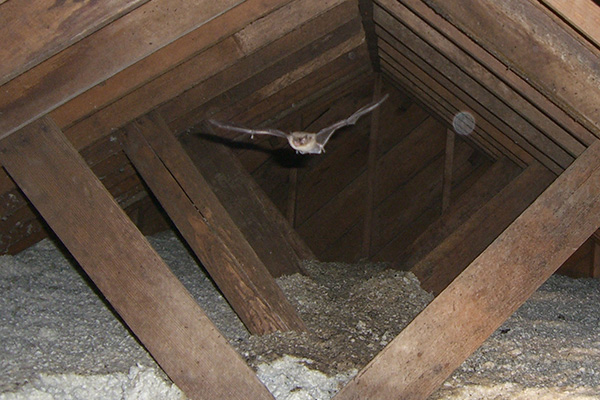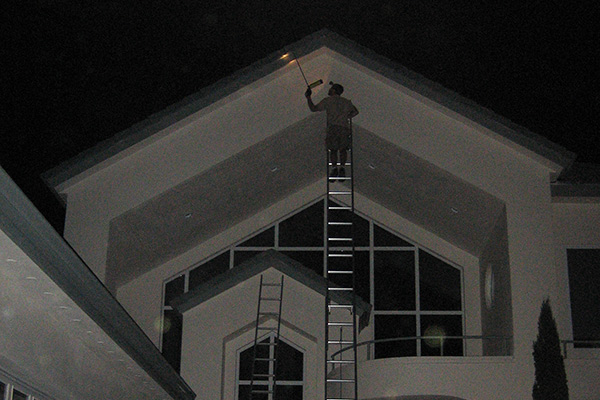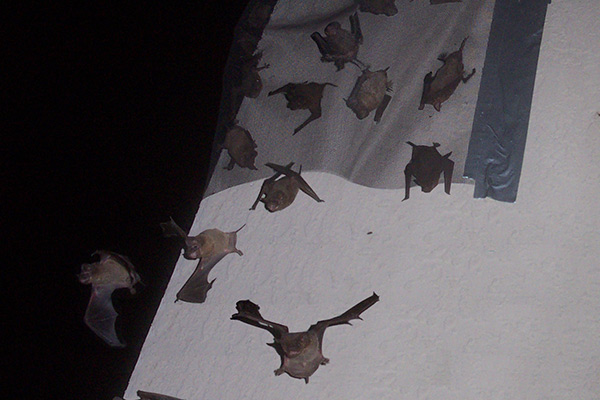- info@animalatticpest.com
- Call - we service 300 locations

How To Get Bats Out of Your Attic
Bats are removed from the attic with a live exclusion. This is the best way. It is the most effective, and the only legal way, as well. A live exclusion means that you install a one-way door or one-way netting devices which allow the bats to exit the building freely, as they do each night, but then not get back inside. It's a simple concept, but it's difficult to execute effectively. Bat removal can be a complex task, because the bats can enter a building through very small cracks - as small as 1/4" - it's amazing! They almost seem to disappear into nothing! The holes and gaps that bats use are usually located high on a building, at roof lines, and can be tricky to access. A bat removal job requires utmost attention to detail. It also requires adherence to state laws protecting bats. For example, never perform a bat exclusion during the summer, because of the flightless baby bat pups in the attic! I myself trained in bat removal for two years, and still needed a fair amount of practice to perform bat removal correctly. Our network of wildlife removal professionals on this site are excellent in bat control. Read more about how much does bat removal cost. Below are the basic steps to getting rid of bats in the attic.
How to Get Rid of Bats in the Attic - 4 How-To Steps
1 - Home & Attic Inspection
Do two crucial things: inspect inside the attic to identify bat species and colony size, and watch the outside of the house at dusk, to see where they are flying out.
2 - Seal Bat Entry Holes
Once you have identified the primary entry/exit spots, LEAVE THEM OPEN, but seal off 100% of secondary areas. It's best done at night, with a light, for better vision.
3 - Perform the Bat Exclusion
Set the bat exclusion funnels or netting on the primary exit holes, which you left open Observe for 3 nights, to make sure the bats can get out but not back in!
HOW MUCH DOES BAT REMOVAL COST? Prices vary depending on the situation. Some jobs are simple, require only one service visit, and might be as low as $100. Some jobs are complex, require multiple service visits, home repairs, attic cleanup, and so on. Prices can also vary by city. To get the best price estimate, call our technician in your area: Click here for a free price quote over the phone in your town.
Information About Bats in the Attic
Are there baby bats? Yes, that's the reason bats enter the attic. These bats can live in very large groups, called maternity colonies. The bats in your attic are all females. They give birth to one pup each, usually in the month of May, but it can vary depending on species or local climate. The pups in the attic are flightless during the summer months, while the females nurse them. This is called the maternity season, and you absolutely cannot perform a bat exclusion during this time, because you will trap the young baby bats inside! It's illegal, and a terrible event, because the baby bats start to crawl around and they often get inside the house, or they starve and die and rot and cause a bit odor problem. It's a horrible thing to kill baby bats! Read more about nest of baby bats in the attic.
What species of bats are in my attic? The United States is home to three common species of colonizing bats: The Little Brown Bat, the Big Brown Bat, and the Mexican Free-Tail Bat. There are some other colonizing species of bats that choose to roost in attics, but those are the major three. You can identify them by entering the attic and spotting them, although to be honest, this can be very hard - they don't just hang from the ceiling or raftors. They clump up in tight packs under gaps, behind beams, down walls, and areas like that. Hundreds of bats can cram into very tight quarters. You can also identify them by observing them fly out. If you live in the south, it's more likely to be Freetail bats, and in the north, the big brown or the little brown, which you can identify by size and size of droppings. It's important to know the species, so you can tell the bat birthing season.
How many bats are in my attic? Your best bet is to watch at dusk and do a count. They don't all leave at the same time, but that will give you a ballpark estimate. But remember, the all-female group in the attuc will give birth to one pup each, usually in the month of May. In August, the young pups start to fly, and suddenly the colony size appears to have doubled! Bats live a long time, and they use the same attic each year or year-round pending temperature, and thus the colony can grow to a very large size over time. I have seen attics that are home to over 5000 bats!
What kind of damage is caused by bats in the attic? Bats are good animals, gentle and beneficial to the environment. They eat a lot of insects, which people seem to like. The only real problem with a colony of bats in the attic is that each bat poops 20-30 times per day (they eat a lot!) and you can do the math. 25 fecal pellets x 365 days = over 9000 bat poops per year per bat. If you have a large colony, the droppings can accumulate. I have personally been inside attics which were loaded with feces over two feet deep throughout the attic, causing the ceilings to cave in. The odor of a colony of bats and their guano can be very strong, and in accumulation, the guano can be a health risk - a place for mold to grow, and can cause potential respiratory infections. For these reasons, many people want to remove the bats in the attic before the problem gets out of hand. Read more about damage from bats in the attic.
How do I trap bats? You don't trap them, you exclude them! Instead of catching them in cages, bats are removed from the attic with a live exclusion. This is the best way. It is the most effective, and the only legal way, as well. A live exclusion means that you install a one-way door or one-way netting devices which allow the bats to exit the building freely, as they do each night, but then not get back inside. It's a simple concept, but it's difficult to execute effectively. Bat removal can be a complex task, because the bats can enter a building through very small cracks - as small as 1/4" - it's amazing! They almost seem to disappear into nothing! The holes and gaps that bats use are usually located high on a building, at roof lines, and can be tricky to access. A bat removal job requires utmost attention to detail. It also requires adherence to state laws protecting bats. For example, never perform a bat exclusion during the summer, because of the flightless baby bat pups in the attic! I myself trained in bat removal for two years, and still needed a fair amount of practice to perform bat removal correctly. Read more about bat trapping.
Can't I just use a bat repellent? No. In my 15+ years as a wildlife removal professional, I have seen it all: attics filled with strobing lights, blaring radios, ultrasonic sound machines, and every type of over-the-counter repellent, from coyote urine flakes, to ammonia, to the end-all-be-all el cheapo scam, mothballs. I once went into an attic in which a desperate old lady had dumped close to 100 lbs. of mothballs in her attic. The bats didn't care! Here's the problem with repellents in general: once a bat lives in your attic, and has a nest of babies there, that's it. That's the only option for survival. There is no device, no repellent that will make them leave. Go ahead and buy a bat repellent at Home Depot, or a bat deterrent device online - waste your time. But they have zero demonstrated effectiveness. Read more about bat repellents.
Can I kill the bats with poison? Lord no! It's illegal, immoral, ineffective, every bad thing! I have seen some attempts by ignorant pest control companies, or exterminators as they are also called, using the same techniques for bats as they do for termites - tenting the entire house and spreading poison. What an ignorant horrible tragedy! Bats aren't bugs! Tenting a house like this is a high-money job for the pest control companies, but if any company ever recommends this, report them to the EPA immediately! In such cases, not all the bats die, anyway. Some of them crawl around in agony in your attic and around the ground, and some live and keep the colony going into the future - bats can live up to 18 years, and despite being small, are survivors. And poisoning doesn't address the root problem, of the holes and gaps in your house that allowed bats inside in the first place. Read more about killing bats with poison.
How do I keep bats away from my house? Maybe you want to prevent bats from coming to your house, roof, chimney, or property in the first place, before they get in the attic. The real key, regarding bats in the attic, is to prevent them from getting inside. To do this, you must inspect the house and seal shut any potential bat entry holes. You can use a variety of materials, such as caulk or expanding foam - bats can't chew their way in like rodents can. That said, you're probably visiting this website because you already have bats, in which case you have to get them out of the house in addition to preventing them in the future. You can read more about how to keep bats away if you want.
How do I do this myself, for cheap? Follow the above 4 steps. First, inspect your attic to find out the species. Be sure it's not the maternity season before starting any bat removal work. If it is, wait until mid-August or later. Next, watch the house at dusk, and preferrably dawn as well, so you can identify EXACTLY where the bats are getting in and out. It can actually be tricky. What looks to you like the edge of the eave could actually be the fascia board, and so on. They sneak out of tiny cracks very quietly. Next, use a ladder and inspect every inch of your house, especially the rooflines, eave gaps, soffits and soffit vents, gable vents, base of chimney, roof peaks, and so on. Seal shut all but the primary entry/exit holes. Watch the house at the next dusk to make sure they are still able to get out. Then install exclusion funnels or netting on these openings. It must be set just right - to allow the bats to fly out, but not back in. Observe at dusk and night to make sure they are able to get out, and if not, remove them immediately. You probably also want to inspect at dawn to make sure they can't get back in at the devices or anywhere else. Watch the exclusion areas for at least 3 nights, to make sure they are all out, and none are trapped inside. When you are absolutely certain all the bats are out, remove the exclusion devices and seal shut those entry holes. Do it perfectly, or the bats will get back in! Next, clean the feces and urine in the attic. Read more about bat feces. The whole process is difficult, and it took me a couple of years and dozens of jobs before I got very good at it, but if you are very careful and work hard, you can do it!
How much does bat removal cost? It varies by the complexity of the job and by the company doing the work. The job requires several service visits, as outlined above. It will certainly cost at least a few hundred dollars, and some bat removal projects are very expensive. But doing it the right way is far cheaper than waiting to do it in the future, when the colony is larger and the guano in the attic has increased significantly. If you want to find out a ballpark price in your town, click here for your local wildlife pro and call, and they will be able to tell you. Our wildlife experts have special licensing & certification regulated by state wildlife laws, as well as all applicable state and local business licenses. They carry liability insurance, due to risks of climbing on roofs, in attics, dealing with dangerous wildlife, etc. They will perform professional grade repairs which results in a permanent solution so you don't have bats again. It is a good investment in your home and protection against further damage. Read more about how much does bat removal cost.
The Bottom Line
How to get rid of bats in the attic - they are not so easily just "gotten rid of". But they can be properly and effectively removed, and the problem can be prevented from happening again. Remember to follow the steps above, whether you do it yourself or hire a professional to do it for you. It is not easy work, but if you don't remove the bats in your attic, they will go on to cause further damage. When you do decide to remove them, please remember to treat the animals with respect, and take the work seriously. You can get rid of bats in the attic if you follow the correct approach. Best of luck!




